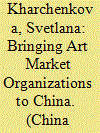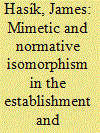| Srl | Item |
| 1 |
ID:
169798


|
|
|
|
|
| Summary/Abstract |
This study proposes a new explanation for institutional differences of organizations in China. It focuses on how two organizational forms dominant in contemporary art markets – commercial galleries and auction houses – were first established in China in the 1990s. Based on archival and interview data, it argues that the organizational forms were introduced to China due to mimetic isomorphism, and that their divergences from the foreign models are the result of unintended consequences of institutional work. It highlights the role of individual agency, including the role of foreign nationals, in organization-building in China. The findings also have implications for institutional theory: the article shows how the political, cultural and institutional context in China shaped institutional work that needed to be conducted and led to unintended consequences of institutional work.
|
|
|
|
|
|
|
|
|
|
|
|
|
|
|
|
| 2 |
ID:
146623


|
|
|
|
|
| Summary/Abstract |
Why do countries have air forces? Organizational alternatives, such as maintaining separate air arms for the army and navy, have become quite rare. The conventional narrative advanced by advocates of independent air forces stress that the primacy of airpower in modern warfare mandates centralized control of most military aviation. In this view, political–military uncertainty has driven mimetic isomorphism – pressure on national governments to organize as others organize so as to fight or deter war just as effectively. However, working from a set of 56 countries that were politically independent within a few years of the establishment of the first ever independent air force (the Royal Air Force) in 1918, and continuing through nearly the present, there is no clear pattern of external military pressure prompting this particular reorganization. Rather, from anecdotal evidence, the cause has more likely been normative isomorphism – a professional craving to look as others look to foster political or personal legitimacy. For whatever reason, though, choices of structures tend to lead to specific choices of policies. Thus, the result suggests that defense ministries looking for more effective or less costly organizational schemas may reasonably consider alternatives to the tripartite army–navy–air force structure.
|
|
|
|
|
|
|
|
|
|
|
|
|
|
|
|